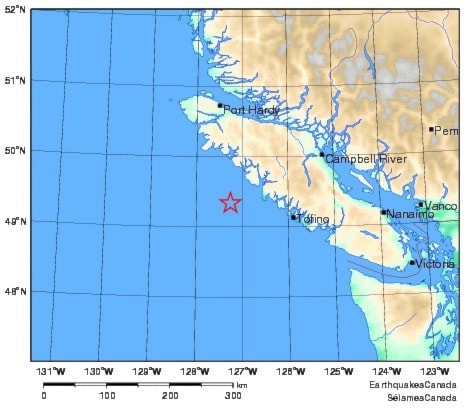A magnitude 6.3 earthquake that struck Friday off the west coast of Vancouver Island did no damage but left residents across southwestern B.C. trading stories of what they felt.
The quake hit at 12:41 p.m. and was centered about 100 kilometres west of Tofino at a depth of 22 kilometres, according to Natural Resources Canada.
Many residents in the Lower Mainland felt nothing, but others report feeling something like a helicopter passing overhead or the reverberation of a passing freight train or construction equipment.
There are also reports of swaying buildings, signs and wires in parts of the Lower Mainland and employees ran out of some stores in Cloverdale.
Residents on parts of Vancouver Island, including Campbell River, say they felt the quake strongly.
"I was sitting at my computer and the whole house shook — the floor, the roof, everything," Bowser resident Gail Carr said. "Even the hanging plant was moving in the kitchen."
Carr ran outside and waited to see if more quakes would come.
"I've got a fan with hanging controls and they were swinging a bit, too, but not wildly," added Qualicum Woods resident Myrett Drummond.
The main quake was followed by more than 100 aftershocks, one as large as 4.9.
The quake was triggered by movement of two ocean plates that meet at the Nootka Fault.
"It's pretty small," SFU geologist Brent Ward said. "People should have felt this on the west coast of Vancouver Island. People in Gold River and Zeballos would have felt it the most."
No tsunami warning was issued.
"It's interesting that so many people felt it in Vancouver," Ward said.
The harmonics of how the quake wave interacted with certain tall buildings may have been a factor, he said.
"I suspect many large buildings were just at the right height to start swaying back and forth to the vibrations of the earthquake wave," he said.
Ward said he felt nothing, but noted he was in a ground floor on bedrock.
A similar-sized quake that was shallower and closer to the Lower Mainland could have been very destructive, he added.
The earthquake that levelled Haiti in 2010 was a magnitude 7 quake 13 kilometres underground.
And Ward noted Vancouver Island was damaged when a 7.4 quake hit close to Courtenay in 1946.
"It caused quite a bit of damage," he said. "It broke a lot of chimneys. Building facades cracked and fell into the street. And there were quite a few landslides."
Another similar-sized quake that was more devastating because of proximity and shallowness was the 1995 Kobe, Japan quake that killed 5,000 people and caused $100 billion of damage.
Seismologists say the quake isn't likely a precursor to a massive megathrust earthquake that's expected to eventually hit the region.
Nor is it likely, Ward said, that this modest quake has relieved stress and made future ones less likely.
Emergency coordinators say it's a wake-up call for families to make preparations for future disasters.
Telus spokesman Shawn Hall said there was minor phone network congestion on parts of Vancouver Island immediately after the quake, causing delays of a second or two to get a dial tone.
"Everybody was phoning everybody else to talk about the earthquake," he said.
In future disasters or incidents, he said, people should avoid making calls unless it's critical.
Hall suggested people make one call to a relative or friend outside the affected region – in another part of B.C. or Canada – and have them relay a message to other family members.
"Ask them to let people know you're okay rather than making a dozen calls yourself," he said. "That relaxes the load on the phone network and ensures it's available for people who do need to make emergency calls."
– with files from Neil Horner (Parksville-Qualicum News)Storify by Kevin Diakiw
